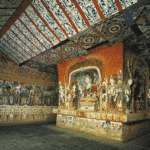Mogao Caves

The Mogao Caves are located southeast of the Dunhuang oasis in Gansu province. Also known as the Caves of the Thousand Buddhas, they are the world’s largest treasure house of Buddhist art. The location lies at a strategic point along the Silk Road, at the crossroads of trade, with religious, cultural and intellectual influences as well.
According to historical records, the carving of the caves started in 366 CE and continued for about 1,000 years. The 492 well-preserved cells and cave sanctuaries in Mogao, housing about 45,000 square meters of murals and more than 2,000 painted sculptures, are known for their statues and wall paintings. The painted clay figures vary greatly in size, with the largest one being 33 meters high and the smallest only 10 centimeters.
Painted clay sculptures and murals in the Mogao Caves have mainly Buddhist themes, but they also include human figures, reflecting various societies and cultures of different times. Besides, they also demonstrate painting styles of different times in layout, design, delineation and coloring, as well as the integration of Chinese and Western arts.
In 1900, a total of 4,500 valuable cultural relics dating from 256 to 1002 CE were found in the “Buddhist Sutra Cave”, including silk paintings, embroidery and documents in rare languages such as ancient Tibetan and Sanskrit. This is regarded as one of the world’s greatest Eastern cultural discoveries.
In 1987, the Mogao Caves became a UNESCO World Heritage Site.

